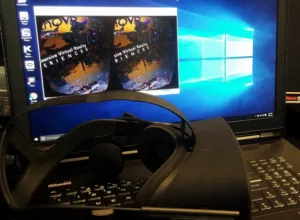Lightspeed Design has built a new VR player platform called the DepthQ VR Film Experience, using its own DQVR codec. The player supports 4:4:4 encoding and CUDA real-time processing. One of the first experiences that will be available is a 90fps flight simulation.
We had some questions about the development, and Lightspeed president Chris Ward took time to answer them.
The DepthQ VR Player uses one-to-one pixel matching with the Oculus CV1’s display, and its native 90fps framerate. Lightspeed’s work is based on a 360° pre-rendered stereoscopic video stream; it is digital film-based, rather than using a game engine like Unity.
To achieve the 4:4:4 sampling and real-time processing, Lightspeed developed a GPU-accelerated M-JPEG codec pipeline. This combines Microsoft’s DirectShow, a GPU-accelerated codec, image manipulation with OpenGL and integration with the Oculus SDK.
Lightspeed did not design the player for most common video uses, he explained. These are well supplied. Instead, it is designed to increase the feeling of ‘presence’ in VR, by maximising visual comfort and experience in content based on filmed or rendered video. He added, “We can also foresee emerging applications in high frame rate VR video in live-capture applications that have a substantial amount of motion or judder, for example drones or perhaps sports events.”
Two other important features are under development. The first is integration of the new player with motion system supplier D-Box; this will enable Lightspeed to create simulated ride experiences. The other is the integration of the DQVR codec with the Unity engine. Lightspeed has several prototype projects combining high performance video with game engine elements, and sees this is as the “true future” of this type of product, said Ward. It would enable both high-quality video and the addition of VR interfaces.
Our last question was about other VR headsets. Ward said that while the focus is on the Oculus Rift, Lightspeed will be able to add support for other HMD technology “in fairly short order.” The company is not currently looking at smartphone-based VR.

